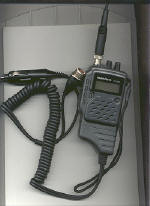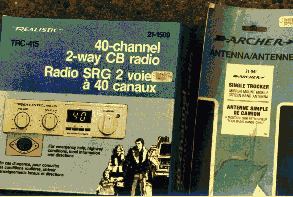|
Communication, in general
aviation can mean the spending of literally thousands of dollars,
for aircraft band radios, headsets, intercoms etc.. A single
headset can cost upwards of $450. In general aviation the headset
and radio are normally mounted into the aircraft, on a permanent
basis. The aircraft like a car protects the instruments inside
from wind and weather, sun and rain. Another advantage is that the
pilot can lock his expensive gear up in the plane which is stored
in his hangar, protected from the midnight aircraft supply folks. headsets, intercoms etc.. A single
headset can cost upwards of $450. In general aviation the headset
and radio are normally mounted into the aircraft, on a permanent
basis. The aircraft like a car protects the instruments inside
from wind and weather, sun and rain. Another advantage is that the
pilot can lock his expensive gear up in the plane which is stored
in his hangar, protected from the midnight aircraft supply folks.
Ultralight pilots and their craft
are usually not as lucky! To leave an expensive radio in an open
or semi open cockpit, on grass strip, subject to prying eyes and
mother nature is just asking for trouble. Still it would be nice
to communicate with your buddies on cross country flights or for
that matter with the wife and kids if you are up flying and just
want someone to talk to.
The answer to the communications
problem is actually very simple to solve. In our case we fly a
little plane called the Buccaneer Amphibian, and if there is one
thing we know it's that there are only two kinds of amphib or float
pilots, those that have gotten wet and those that are going to get
wet. So for us to spend thousands of dollars setting up with
aircraft band radios etc., would just be a waste of time and
money. The solution was to find something relatively cheap, easy
to install, easy to remove, with a repair centre close at hand,
that could be bought anywhere we sold a plane, and that was backed
by a large company so that if we needed parts or repairs that
company would still be in business, years down the road. Of course
most important, the system also had to work!
The solution was CB radios from
Radio Shack, (model TRC415) at about $149.00 or a TRC 232 at
$179.00, mirror mount mid
loaded antennas from Radio Shack, (model 21941 single trucker)
Ultra com audio equipped helmets from Comtronics Engineering,
mated to one of Comptronics CB patch cords with a push to talk
switch
available from the Light Sport & Ultralight Aircraft Information..

Also required is a Rotax voltage
regulator, available from any ultralight supply depot,
the Light Sport & Ultralight Aircraft Information. is
one of the largest in Canada and a small 12 volt
battery (if you want you can simply hook the radio up the battery
it draws very little power and the battery can be charged from
your cars cigarette lighter).
We also found that a slide in quick
disconnect panel for the radio from Radio Shack worked nicely.
All
you have to do when you want to remove the radio is pull it out of
the quick disconnect disconnect mount, no cables, lines or plugs
to undo.
886 080
Single Phase Regulator
(Used on 377/447/503/532 with points ignition) |
264 870
Phase Regulator
(recommended for
503/582 DCDI) |
|
Regulator rectifiers |
Once you have hooked up your two
yellow leads from your engine to the two yellow leads on the
regulator, (on Rotax and Cayuna engines) you have 12 volt power
coming off the red lead on the regulator. Now run a ground to the
battery, run the positive from the regulator to the battery and
you have a charging system. The next step is to connect the
antennae, using the mirror mount bracket supplied, it will mount
to almost any round tube, or you
can remove half the bracket and bolt it to the root tube on most
root tube style ultralights.
Once the antenna is mounted, and
the power supplied to the radio via the battery, the next step is
to mount the quick disconnect mount using worm drive clamps or
whatever else is handy. (Most of the Shack radios come with mounts
to mount under a car dash and they are easily adapted). With the
mounting complete find one of those local CB enthusiasts and have
him come over and check your radio for output.
Our radios when
properly matched, at 1,000 feet can reach close to 7 miles
clearly, plane to plane
 and over 30 miles plane to a base station.
You might find that you will have to turn your squelch up about
half way to eliminate all the static and skip, but communication
between planes is effected very little. and over 30 miles plane to a base station.
You might find that you will have to turn your squelch up about
half way to eliminate all the static and skip, but communication
between planes is effected very little.
Another advantage that we have
found with the CB system over conventional aircraft radios is the
ability to talk to boaters, cars, police etc., and even other
conventional aircraft.
In more than one case we have been unable
to reach one of our aircraft, because of distance between us, but
have been able to contact a base station, and they have relayed
messages back and forth until communications were restored. In
other cases pilots were able to arrange for help to come to their
aid when down in a field miles from nowhere, when a passing
motorist picked up their call for assistance.
Believe me there is nothing like
CB communications when 6 aircraft set out on a cross country and 1
gets lost. We have not found engine noise to be a factor, and the
initial cost is quite inexpensive, when you consider you should
fly with a helmet and ear protection anyway. In our case we use
the battery to run a little bilge pump, and on wet days use the
aerials to hang our wet clothes.
|